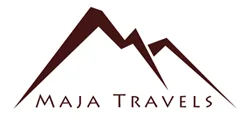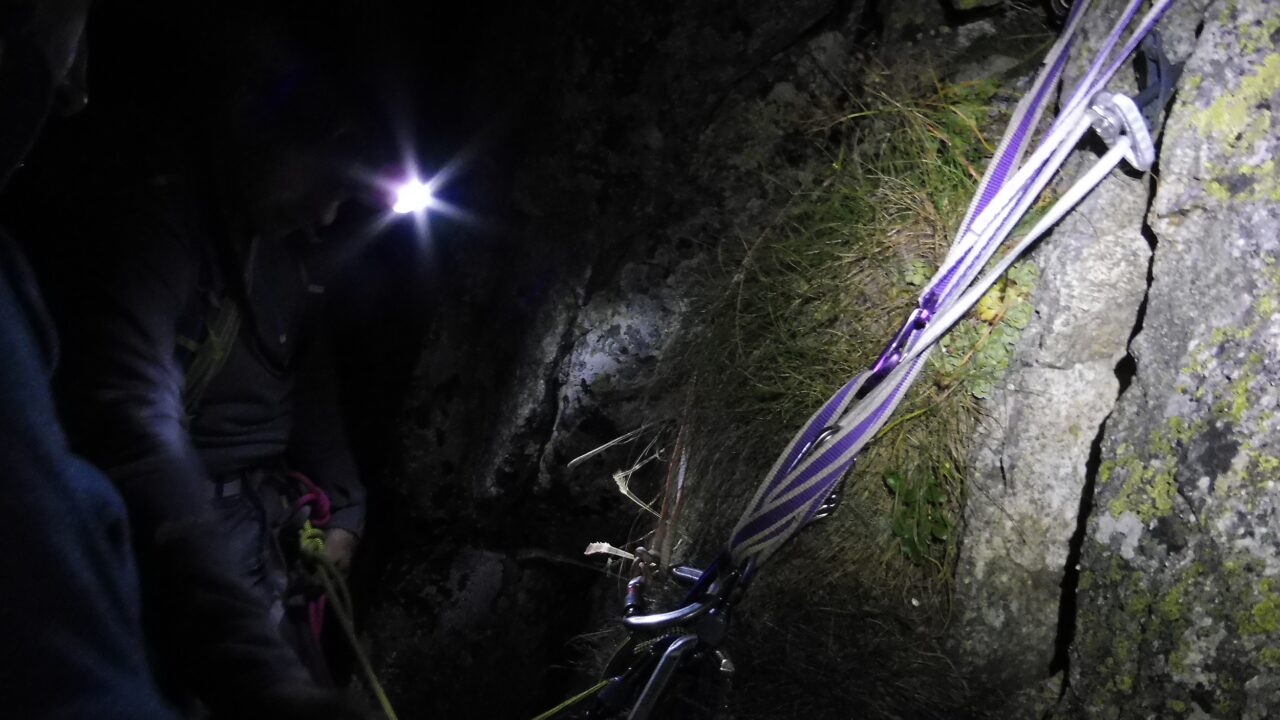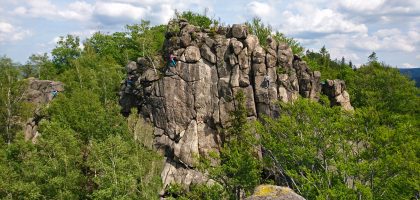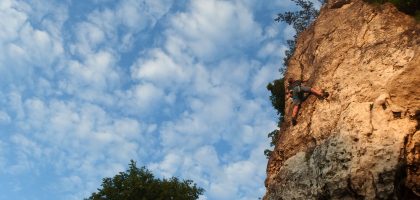Multi-pitch climbing is not a piece of cake. Things don’t always go according to plan ;) Read what didn’t go well during my climbs and how to prevent problems.
I have been climbing for 5 years. In 2018 I did a rock climbing course and a year later a mountaineering course. Apart from the courses, I climbed on multi-pitch routes in the Tatra Mountains, Sokoliki and Rudawy, Jura, Montserrat and Costa Blanca in Spain, Leonidio in Greece and Sicily. Everywhere, however, there were single routes or a maximum of several.
I still feel like a novice multi-pitch climber and it so happens that I always climb with people with similar or less experience than me. That’s why things don’t always go as we’d like, and in fact, usually something goes wrong ;) However, I can already see what mistakes we make most often.
1. Underestimating the time it takes to complete a route
I noticed that beginners have a problem with estimating how much time they will need to make a multi-pitch route and to get down after its completion. Specifically, they often think they’ll do it faster than they actually do.
The first example – 2018, Jastrzębia Turnia in Sokoliki. We combined with a friend different routes and in this way we created a 3-pitch route (Sosna Direct, Wejściówka, Komin Zipsera). When my friend finished the first pitch, I looked at my watch – it was one hour to sunset. It crossed my mind that maybe I should take the headlamp, but after a while I rejected this thought, stating that I’m exaggerating and we will definitely make it in time. The first pitch is VI, but I’m going as the second one, the second one is II, and the third one is V, so it should go quickly. After all, we were at the top an hour after sunset ;) And the only light we had was the flashlight on my smartphone.
Dlaczego tak długo? No jakoś tak szybko minął czas… Już na początku trzeciego wyciągu zaczęło się ściemniać. Zamiast wspinać się jak najszybciej, zaczęłam wtedy kombinować, co by tu zrobić. Szukałam, czy może jest gdzieś w pobliżu stanowisko, z którego moglibyśmy zjechać, bo nasze było na własnej asekuracji. A może moglibyśmy po prostu zejść? Hm… chyba gdzieś tu była zejściówka, tylko gdzie dokładnie? W końcu zaczęłam się wspinać, ale pojawiły się trudności, z którymi miałam problem. Zeszłam i zamieniliśmy się na prowadzeniu, a w tym czasie czas mijał…
Next year – the Tatra Mountains, Koscielec, Droga Byczkowskiego. Already after the second pitch, we saw that we had no chance to reach the top before sunset and it was one of the reasons, why we decided to retreat. I would have to write a long story to explain what happened during the retreat. All I can say is that these two pitches plus getting back to the bottom of the wall took us 6 hours.
A year later, the Tatra Mountains again, this time Zamarła Turnia and the Lewa Pilchówka route. We left quite late, after getting to the route for an hour we were preparing, eating and looking at the wall, while climbing we were slow from the beginning, because were the 3-person team of not very experienced climbers and then our friends got a little lost. First one went to the belay station from the adjacent road. Then the second one, which led the next pitch, was supposed to go up a bit, then turn left and come back on our route. However, he climbed too high, got stuck in the area where he could not belay himself and finally got out of it, but in the meantime the sun had set and we were doing the last pitch in the dark. This time with headlamps ;)
The last example, this year – Sicily, Pizzo Monaco and the 6-pitch traditional road Pace di Chiostro. It took us 10 hours, of which 3 hours was to get down after finishing it. Why so long? We started late, being sure that we would make it before sunset (but wisely we took the headlamps anyway). It turned out, however, that we are slower than we thought and my friend got a little lost on the last pitch. The effect was that it was already dark at the rappel anchor. From the guidebook, we only knew that the descent is 60 m long (not along the route, but on the other side of the rock) and then you have to go down along a vague path. My friend was rappeling first and it took him a long time, because the rope dropped down got caught in thorny bushes. After rappeling to the end of the rope, he said that he didn’t know if he should go down here because there was no path in sight. While I was rappeling, I tried to look around in search of a place that looked like a place we should rappel to and by the way I spotted a rappel anchor from a different route. I thought I’d use it because we might need the ability to go lower. I tied the rope through the ring… and now I was struggling to get it down because it kept catching on the bushes. In the end, however, I rappeled to my friend and from there we got down on foot, but it required weaving through cacti and other bushes, because we found the path only at the end.
The funny thing is that this route was supposed to be a warm-up and a test to see if we had a chance to do Via Fratelli Titt. It’s a classic in the area. 18 pitches, of which the first 8 are bolted and the next ones traditional. Most of the pitches are easy but there are also two 5c’s and the hardest here was 5a. Already after the second pitch I knew that we had no chance of Via Fratelli Titt, and on the last pitch I started to wonder how we could even consider such an option, that maybe we would make it ;)
2. Starting the route without proper knowledge about it
By this I mean both knowledge about the route up and down, as well as knowledge about weather conditions.
On the Droga Byczkowskiego, we decided to retreat not only because it was late, but also because we were cold. It was already autumn and the temperature was quite high, but looking at the forecasts we did not pay attention to the speed and direction of the wind…
In turn, in Sicily, it was too hot for us. In the guidebook we saw that the rock has a north and north-west exposure, so we expected that the sun would not show up until late afternoon. It was only when we were under the rock that we noticed that our route runs along a pillar and already at the start, at 10:30 the sun was there. This led to both of us dehydrating quickly because we didn’t take the right amount of fluids for these conditions. Instead of enjoying the climb, all we thought about was going up and back down.
On Jastrzębia Turnia, we were rappeling the wrong way, because we hadn’t read about it before… Instead of rappeling in one pitch on the lower, eastern side, we were going down in two pitches on the side from which we started climbing. We struggled to get the rope down from the top anchor, because the anchor we used as an intermediate one was too far to the side and shouldn’t be used for that purpose.
After finishing Lewa Pilchówka, instead of immediately packing the gear and starting the descent, we were walking around in search of the rappel anchor. I remembered from nearby Droga Motyka route that we were rappeling a bit to get to the hiking trail and we thought it would be the same here. It took us a while to realize that we were almost on the trail :D
In Montserrat we went climbing on the route that was not suited to our single 70m rope. The pitches had a maximum length of 25 m, but not all belay anchors had rappel rings. On some, only bolts, because it was expected that climbers would omit them while rappeling. We had to rappel on two such anchors. It probably damaged the rope a bit and we left one carabiner, afraid that otherwise we wouldn’t be able to pull the rope.
3. Making rope drag
This problem occurs most often on trad climbing routes, but since most multi-pitches, especially in Poland, are traditional, I will also talk about it.
Let’s go back to Droga Byczkowskigo :) We lost a lot of time on the second pitch, because our friend couldn’t handle the rope. First he was struggling with one half of the rope, then the other, then two. Finally he reached the belay anchor, but he said that he couldn’t belay because he didn’t have the strength ;) I think that an additional factor that made it difficult for him to lead the rope was that the first belay was too low. But I didn’t notice it then, only after I got home, when I looked more closely at the route schema and the photo of the rock. And here we return to point 2, i.e. insufficient knowledge of the route.
Good thing we were there in 4 people team. Boys in the first team and me with a friend in the second. While leading, I uncliped his rope from several anchors, corrected others and thanks to that he could belay his friend.
But I’m not much better. I kind of know that the rope can’t go zigzag, because then the forces work so much that it becomes difficult to pull it. I kind of know that you have to extend the protection and embed it in the right places to prevent it. And even so, a few times it happened to me that at the end of the pitch I had to pull the rope behind me with my hands, because I was unable to climb normally. I guess it just takes more practice.
Conclusions
Most accidents happen because several mistakes overlapped. It is true that during my climbs there was no accident or the need to be rescued by TOPR or other services, but they show well how one mistake can make another more problematic.
Too thin clothing on the Droga Byczkowskiego would not be such a big problem if we all climbed efficiently. Because when our friend was struggling with the ropes, we were standing and freezing. Similarly, his mistakes in leading the rope would not be so problematic if we were properly dressed. On Zamarła Turnia, our lack of knowledge about the descent trail would not have been a problem if we hadn’t made mistakes earlier that made it so late. The same Pizzo Monaco… In the daytime we would have easily see where we were. And on Jastrzębia Turnia, perhaps it would be enough to take a headlamp to see which way we should go down.
PS. In the mountains it is really worth having walkie-talkies! Already on the mountaineering course, where we did not have them, I saw that it is often impossible to communicate without them and I always take them on long climbing routes. I’ve never made mistake not taking them, but it seems to me that only few climbers use walkie-talkies on multipitches. I can’t imagine how we would manage during the retreat at Droga Byczkowskiego, not being able to communicate freely with each other. Or with problems with the descent of Pizzo Monaco … and in many other situations where the climber would not know whether he can climb or not yet.
![]()







Leave a Reply